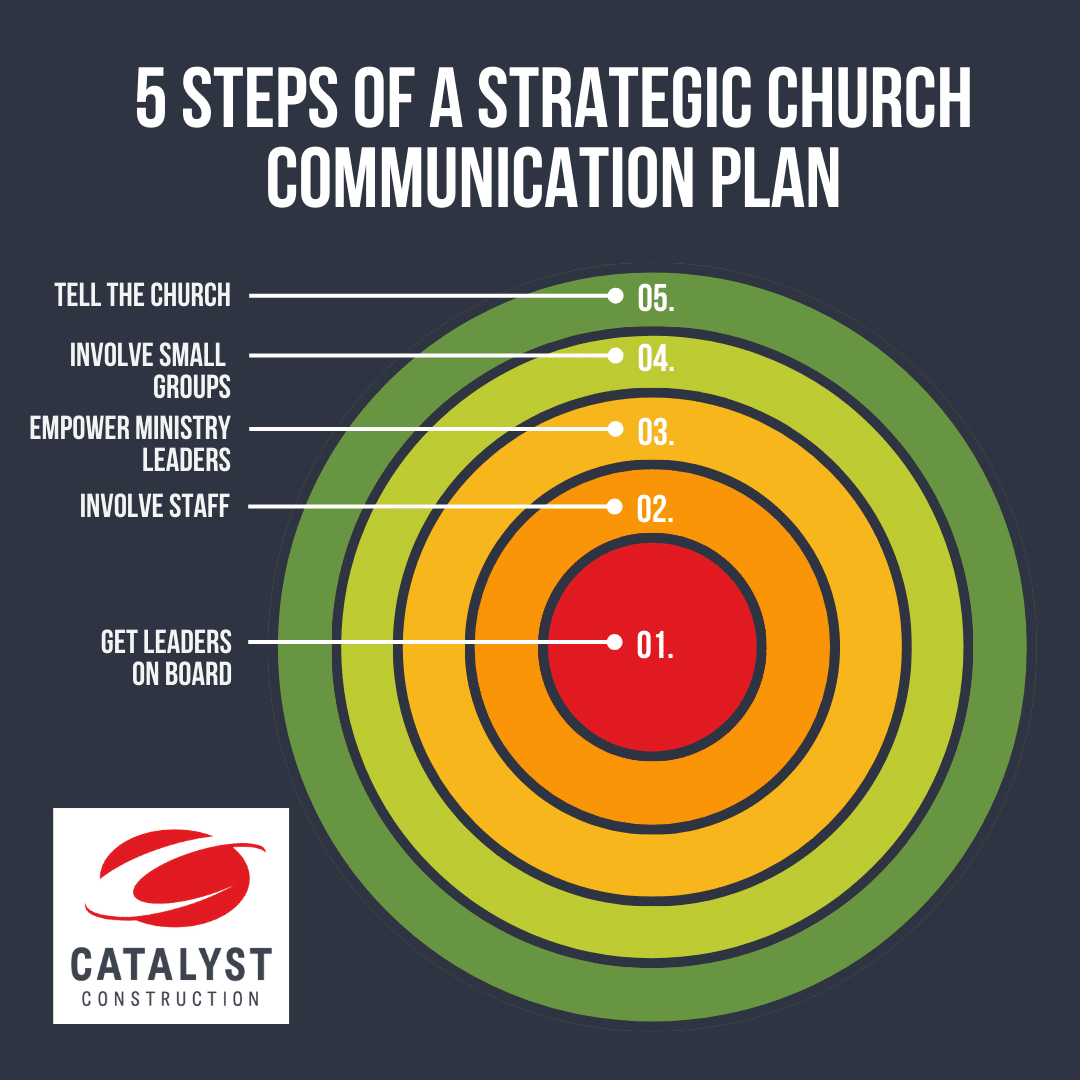There are times in life when you only get one shot. How you approach these moments can build momentum and position you for success.
But if you approach the opportunity flippantly, you may waste valuable resources, add frustration to your life, and create work that could have been avoided.
Defining moments in your church’s life don’t come around often. Momentum gets diluted if you aren’t deliberate in how you approach them. Vision gets clouded.
There is a better way forward. Church communication matters. Pastors – you can give your people the clarity they need to follow the direction you’re setting.
Do You Have a Church Communication Strategy?
Not everyone needs to know everything. But when everyone should, it’s imperative that the right people get the right information in the right order.
Do you have a strategic communication plan for disseminating essential information?
Most pastors don’t.
Consequently, communication often gets spread through a combination of a game of telephone, email blasts, and preaching.
This mish-mash approach leaves the congregation confused. When leaders communicate poorly for what could become a defining moment in the life of their church, opportunities can get squandered.
But it doesn’t have to be this way.
Implement these five steps for strategic communication, and you will:
- Increase ownership in your congregation
- Empower leaders
- Increase clarity,
- Enhance the momentum needed to achieve your goals.
It’s all right here, waiting for you to implement each step and activate your congregation!
5 Steps of a Strategic Church Communication Plan
Leadership expert Patrick Lencioni refers to this as “cascading information.” Picture how water would flow down from the top of a pyramid.
Or perhaps consider concentric circles, like a target for archery.
That’s how information should flow through your church during your church’s defining moments. If you are considering making a significant decision, such as constructing a new building or adding an addition, applying this church communication strategy is essential.
This may seem a bit laborious. And it is – at first. But it will save you so much time and heartache. Pastor and leadership expert Andy Stanley was right when he said that vision leaks.
If you follow these steps, you will reinforce vision at every point in the process. Leaders will be empowered as ambassadors. And you will capitalize on the once-in-a-lifetime, defining moment in the life of your church!
Here’s how.
1: Get the Leaders On Board
Start at the top. Your leadership team board must be on board. Both with the overall vision, and a level of detail that will empower them in conversations.
If you have determined it’s time to find a new home for your church to worship in, the leaders must be on board.
They shouldn’t be surprised by any “announcements” or vision casting to the general masses.
And until you have consensus at that leadership level, no one else in the congregation should be in on the conversation for these higher-level decisions that deal with the future direction of your church.
While the leaders must be on the same page, they don’t have to be on the same paragraph. There is room for some disagreement, but you must have alignment on the decision to move forward.
When you include the key leadership (staff and board leaders), you give them the respect they deserve. It allows them an opportunity to own the vision.
When they do, you will have a team who can help strategically spread the vision.
Three Methods to Involve Your Board
Here are three simple ways to build trust and ownership among your board:
- Discuss the vision during scheduled meetings
- Invite outside perspectives from your denomination, church network or industry leaders
- Schedule a leadership retreat for further processing based on complexity or alignment needs
2: Involve All Staff
Once key leadership shares a unified vision, you must involve your key staff in the conversation before anyone else.
Some of the same concepts apply here as with the key leadership. The general ministry and admin staff shouldn’t be sideswiped by significant decisions impacting their day-to-day responsibilities and potentially their career.
Many of these staff members will be the first people to go to with questions when you move to the general public communication. You want to make sure they are on the same page to help answer the questions that come to them.
There are several differences between communicating with your key staff and the leadership board.
First, the staff will most likely be informed of the direction rather than creating it.
Second, staff are often responsible for implementing the vision rather than overseeing it.
Third, the everyday life of your staff will be impacted directly – especially if they are paid.
Invite Your Staff into the Conversation with These Methods
A little intentionality can go a long way. Here are three principles to utilize.
- Discuss directly during one-on-one meetings
- Give space for questions and processing
- Share resources that helped clarify the vision
3: Empower Ministry Leaders in Your Church Communication Plan
The next layer of leadership to involve is those responsible for leading groups of people. This may be the “point” leader for Sunday School, worship, small groups, or other ministries.
Regardless of your specific ministry structure, most churches have volunteer leaders leading volunteer teams or small groups.
These leaders must be brought into the conversation next. They are some of the best ambassadors of the vision. The process can look slightly different at this level, however.
With your volunteer leaders, you may delegate some of the direct communication to your staff and key leadership.
That is – you may not need to be the one who communicates the vision directly with the volunteer leaders.
Depending on the size of your church, you may not be able to. And since these leaders must be honored and involved, you may need to empower staff to share the vision at this level.
When thinking through which leaders need to be brought into the conversation, don’t overlook those who have social influence in your congregation – without a title.
Leadership is far more about influence than titles.
Keep an eye out for experts in your church who may be able to add value to the steps you’re taking. For example, if you’re purchasing a new facility, it would be wise to involve real estate agents who may be a part of your congregation.
This does not necessarily mean that the experts in a given field should lead teams. But it would be wise to incorporate their counsel when making decisions.
During this stage of the process, it is crucial to ensure that your influential leaders are given the appropriate recognition, respect, and involvement. This is because it is doubtful that any information will remain confidential after this point.
How Do You Involve Ministry Leads?
Ministry leaders may have the most direct opportunity to serve as ambassadors for church communication during defining moments. Empower them by using these four tools.
- Craft vision in writing to ensure clear, consistent communication
- Delegate communication to direct reports
- Follow up with direct reports on the communication
- Create a feedback loop to ensure people are heard
I will often use a “one-pager” when meeting with leaders one-on-one. This is a bullet-point list of the main topics the leaders need to be made aware of.
This helps ensure that I don’t miss anything. I will also give it to them after the meeting so they can easily reference what we discussed.
4: Trust Small Groups to Enhance Church Communication
How does your church organize its smaller, more relational groupings? Whether it’s Bible study groups, small groups, missional communities – or something else – these groups need to be made aware of the vision the church is pursuing. This can be accomplished with informed group leaders.
People may disagree. That’s okay. The reality is you won’t get everyone in full agreement on everything. Be mindful of wasting energy on people who do not clearly understand what is happening and why. Every church has these people, who I often reference as the EGR people (Extra Grace Required).
Write it down. If you find that writing is not your strong suit, consider scheduling a meeting with someone who excels in this area. Don’t overlook this step. Delegate it if necessary.
This is the point in the process where you are at the greatest risk of miscommunication or misunderstanding. Ensure that the leaders responsible for sharing the vision have the information they need – in writing – to play their part.
Why?
At this point, you are spreading the vision amongst the entire congregation. And people will share their perspectives and bring their questions to the people they trust.
If you’ve followed these steps, you will have teams of people enhancing the vision, bringing clarity, and maintaining unity – all allowing momentum to build organically.
How can you involve small groups?
Now we’re talking! Here are three ways to ensure clear church communication in small groups.
- Make sure your small group leaders are informed
- Ask to visit personally to share the vision
- Invite questions and conversation
5: Tell It to the Church
Finally. Phew. NOW you can tell the whole church. Preach it, and announce it over several weeks. Blast it through the emails. Add it to the website.
When you do, you’ll look out over a congregation of people who are engaged, excited, and hopefully eager to step into this time that could be a defining moment in the life of your church.
Doesn’t that sound so much better than looking out over a sea of faces filled with confusion and apprehension?
These five simple steps will set you – and your entire congregation – up for success.
How Do You Involve the Church?
Now’s the time to utilize every communication channel you have available. Consider these options.
- Share the vision from the front
- Consider crafting a teaching series to communicate the vision in depth
- Incorporate announcements in the bulletin
- Employ the understood communication system. Email, text, bulletin, mail, etc
- Utilize social media and ask your followers to share as well
- Add a section to your website
Catalyst Construction Can Help Your Church Thrive
We want to see you succeed. I am passionate about helping churches navigate their defining moments. The stakes are high. Miscommunication at defining moments can stall and possibly at worst, divide a church
I’ve seen it happen.
But thoughtful, deliberate communication during the defining moments will give you your best shot at achieving your vision, without the confusion and angst that follows the lack of a good communication plan.
Not every decision a church makes needs to follow these steps. But the major ones, the life-shaping ones, must.
Leveraging this strategy for cascading information allows the burden of church communication to be shared. It doesn’t all have to rest on your shoulders.
Our strategy also mitigates misinformation, confusion, and hurt feelings. It empowers people and creates a sense of ownership.
With 16 years of experience as an executive pastor and church consultant, I’ve seen this strategy work.
We’d be honored to come alongside you and serve as a guide who can help you achieve the dreams you deserve to live in.
Reach out today for a free consultation!






